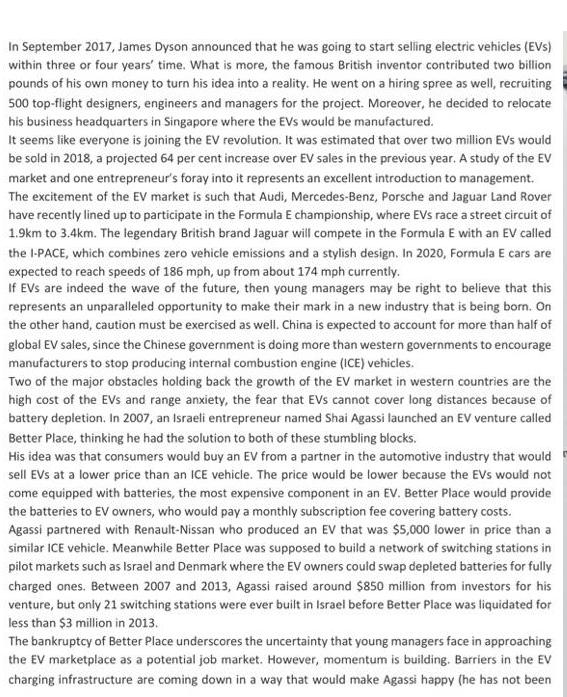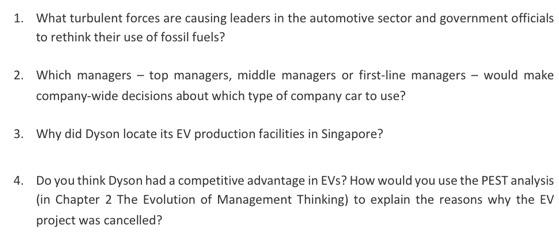Answered step by step
Verified Expert Solution
Question
1 Approved Answer
In September 2017, James Dyson announced that he was going to start selling electric vehicles (EVS) within three or four years' time. What is



In September 2017, James Dyson announced that he was going to start selling electric vehicles (EVS) within three or four years' time. What is more, the famous British inventor contributed two billion pounds of his own money to turn his idea into a reality. He went on a hiring spree as well, recruiting 500 top-flight designers, engineers and managers for the project. Moreover, he decided to relocate his business headquarters in Singapore where the EVs would be manufactured. It seems like everyone is joining the EV revolution. It was estimated that over two million EVs would be sold in 2018, a projected 64 per cent increase over EV sales in the previous year. A study of the EV market and one entrepreneur's foray into it represents an excellent introduction to management. The excitement of the EV market is such that Audi, Mercedes-Benz, Porsche and Jaguar Land Rover have recently lined up to participate in the Formula E championship, where EVS race a street circuit of 1.9km to 3.4km. The legendary British brand Jaguar will compete in the Formula E with an EV called the I-PACE, which combines zero vehicle emissions and a stylish design. In 2020, Formula E cars are expected to reach speeds of 186 mph, up from about 174 mph currently. If EVS are indeed the wave of the future, then young managers may be right to believe that this represents an unparalleled opportunity to make their mark in a new industry that is being born. On the other hand, caution must be exercised as well. China is expected to account for more than half of global EV sales, since the Chinese government is doing more than western governments to encourage manufacturers to stop producing internal combustion engine (ICE) vehicles. Two of the major obstacles holding back the growth of the EV market in western countries are the high cost of the EVs and range anxiety, the fear that EVS cannot cover long distances because of battery depletion. In 2007, an Israeli entrepreneur named Shai Agassi launched an EV venture called Better Place, thinking he had the solution to both of these stumbling blocks. His idea was that consumers would buy an EV from a partner in the automotive industry that would sell EVs at a lower price than an ICE vehicle. The price would be lower because the EVs would not come equipped with batteries, the most expensive component in an EV. Better Place would provide the batteries to EV owners, who would pay a monthly subscription fee covering battery costs. Agassi partnered with Renault-Nissan who produced an EV that was $5,000 lower in price than a similar ICE vehicle. Meanwhile Better Place was supposed to build a network of switching stations in pilot markets such as Israel and Denmark where the EV owners could swap depleted batteries for fully charged ones. Between 2007 and 2013, Agassi raised around $850 million from investors for his venture, but only 21 switching stations were ever built in Israel before Better Place was liquidated for less than $3 million in 2013. The bankruptcy of Better Place underscores the uncertainty that young managers face in approaching the EV marketplace as a potential job market. However, momentum is building. Barriers in the EV charging infrastructure are coming down in a way that would make Agassi happy (he has not been heard of since the debacle). In October 2018, France's EDF promised to open 75,000 EV charging stations across Belgium, France, Italy and the UK by 2022, which would give the power utility a 30 per cent market share in EV charging. As for the EV sticker price shock, countries such as Norway have offered generous incentives to purchasers of EV vehicles to improve sales. Dyson was convinced that he could make a successful launch of his EVs in 2021, and that he could overcome the barriers to entry. He also wanted to attract more managers, designers and engineers to join his company. In 2016, he launched his own university called the Dyson Institute of Engineering and Technology, which is located on his R&D campus at Malmesbury, Wiltshire. Dyson believes that the UK is not training enough engineers and will be one million engineers short by 2022. He also thought he had the solution to range anxiety. His solution would have been twofold. First, he thought he could build a longer-lasting battery and second, he thought he could build more efficient motors that would need less energy to operate. Indeed, Dyson committed 1 billion to battery development and another 1 billion to designing the motors for the car. His ideas were based on years of experience in building cordless vacuum cleaners that have longer battery life and digital precision motors. Dyson doubled the battery life of his latest cordless vacuum cleaner, the V10. The vacuum cleaners also come equipped with a miniature digital motor that runs at 125,000 rpm, which is eight times faster than a Formula One engine. In November 2018, Dyson decided that he would build his first EV manufacturing facility in Singapore, ruling out Britain, and in January 2019, he opted to move his HQ to the city-state. Dyson manufactures all products in factories scattered throughout Singapore, Malaysia and the Philippines. He has his largest R&D facilities in the UK employing about 4,000 staff, a smaller R&D centre in Singapore and a much smaller R&D centre in Shanghai with 50 engineers and managers. He chose Singapore because it was the most logical place to build EVs since it would be close to existing suppliers and customers. At the regional level, Asia is the largest market for Dyson. Dyson, of course, was not the only game in town. Most global automakers have recently announced plans to electrify their vehicles or expand their EV models over the next ten years, including VW, Daimler-Benz, BMW, Renault-Nissan and Toyota. With urban air pollution a major concern, the European Union wants to cut car and van carbon dioxide emissions by 35 per cent or more by 2030, which will push buyers and automakers away from diesel and towards EVs. However, in October 2019 Dyson announced that it was cancelling its EV plans despite having built a "fantastic" prototype because it was not commercially viable. Dyson is now going to reallocate the 2 billion meant for EV production towards existing or new product development and hopefully most of the 500 EV engineers will be reassigned internally. 1. What turbulent forces are causing leaders in the automotive sector and government officials to rethink their use of fossil fuels? 2. Which managers - top managers, middle managers or first-line managers would make company-wide decisions about which type of company car to use? 3. Why did Dyson locate its EV production facilities in Singapore? 4. Do you think Dyson had a competitive advantage in EVs? How would you use the PEST analysis (in Chapter 2 The Evolution of Management Thinking) to explain the reasons why the EV project was cancelled?
Step by Step Solution
★★★★★
3.44 Rating (154 Votes )
There are 3 Steps involved in it
Step: 1
1 The turbulent forces causing leaders in the automotive sector and government officials to rethink their use of fossil fuels include Environmental concerns The growing awareness and concern about cli...
Get Instant Access to Expert-Tailored Solutions
See step-by-step solutions with expert insights and AI powered tools for academic success
Step: 2

Step: 3

Ace Your Homework with AI
Get the answers you need in no time with our AI-driven, step-by-step assistance
Get Started


